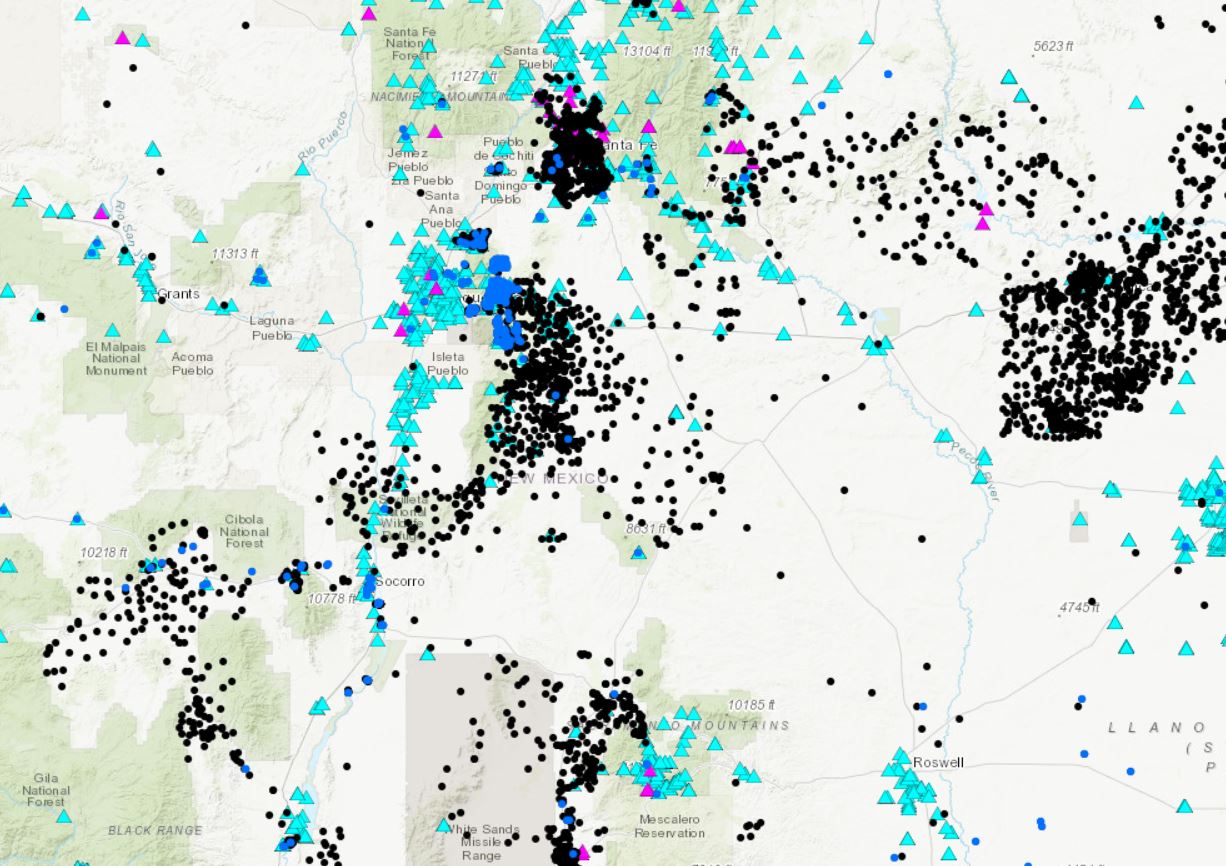The Ogallala aquifer is rapidly declining.
The large underground reservoir stretches from Wyoming and the Dakotas to New Mexico, with segments crossing key farmland in Texas, Nebraska, Kansas and Oklahoma. It serves as the main water source for what’s known as the breadbasket of America — an area that contributes at least a fifth of the total annual agricultural harvest in the United States.
The U.S. Geological Survey began warning about the aquifer’s depletion in the 1960s, though the severity of the issue seems to have only recently hit the mainstream. Farmers in places like Kansas are now grappling with the reality of dried up wells.

In New Mexico, the situation is more dire. The portions of the aquifer in eastern New Mexico are shallower than in other agricultural zones, and the water supply is running low.
In 2016, the New Mexico Bureau of Geology and Mineral Resources sent a team to Curry and Roosevelt counties to evaluate the lifespan of the aquifer. The news was not good. Researchers determined some areas of aquifer had just three to five years left before it would run dry given the current usage levels, potentially leaving thousands of residents and farmers without any local water source.
The news left local decision-makers in the region weighing options to balance farmland demand for irrigation and community needs for drinking water while a more permanent solution is put into place.
“There’s no policy in place to provide for that scenario,” David Landsford, who is currently mayor of Clovis and chairman of the Eastern New Mexico Water Utility Authority told NM Political Report.
Climate researchers and hydrogeologists agree these types of water scarcity issues will likely become more commonplace in the southwest and beyond as the climate further warms.
“Climate change, especially in the west and southwest, is already impacting us,” said Stacy Timmons, associate director of hydrogeology programs at the Bureau of Geology and Mineral Resources, at a National Ground Water Association conference in Albuquerque.
“There’s some places where we’re seeing some pretty remarkable declines in water availability that are, in some ways, reflecting climate change,” Timmons said. “You can see, just over the last twenty years, there’s been some pretty significant drought impacts to New Mexico, specifically.”
Timmons has assembled a team to head up a new initiative to help the state better track water use, quality and scarcity. The program revolves around data: aggregating all the water data that’s collected across different sectors, government agencies and research organizations in the state. The idea is that by collecting that data in one central location and making it available to everyone, policy makers will have a better understanding not only of current water resources, but also how to shape water management policies moving forward to reflect that reality.
“There’s a huge shift globally and nationally in how we’re looking at water,” Timmons said. “Here in New Mexico, we are really on the cutting edge of actually accessing some of this technology, and we’re starting to modernize how we manage our water and our water data.”
Water Data Act
New Mexico became only the second state in the country to prioritize water data management in statute when the Legislature passed the Water Data Act in 2019. The legislation garnered support from ranchers, farmers, environmentalists and, ultimately, state lawmakers. It passed both the House and Senate unanimously.
The Water Data Act aims to develop a modern, integrated approach to collecting, sharing and using water data. The act also established a fund to accept both state funds and grants and donations to support improvements to water data collection state-wide.
“It’s a tool in the tool box that’s going to help New Mexico as a whole manage our water,” said Rep. Gail Armstrong, R-Magdalena, one of the bill’s sponsors. “If it’s all kept in one place and is readily available, that becomes a tool for management.”
RELATED: Running Dry: Groundwater levels are dropping across the West, including in the East Mountains
The program is just now getting off the ground, Timmons said. Part of the work has been to secure additional funding to run the program effectively, after much of the budget appropriation for the initiative was stripped from the legislation in committee.
“We have $110,000 to launch this effort — which is not enough, I will say,” Timmons said, but added that her team was able to leverage that money to receive additional grants and philanthropic funds.
The program will only be as effective as its data is descriptive — and getting all the data into the same place, in the same format, is a challenge. While government agencies and departments, including the USGS, the Interstate Stream Commission, the Office of the State Engineer and the New Mexico Environment Department, all collect and manage water data, they do so in different ways.
“There’s four or five or ten different agencies that have data about one location, but right now we don’t have one unifying way to coordinate all of those data sets,” Timmons said. “Everyone has their own way of managing it.”
And the team is also identifying where there are gaps in water data collection that can be addressed in the future.
“A lot of our rural parts of the state, there’s not a whole lot of data on them,” Timmons said. “There’s huge swaths of land where there are some water resources, there are some people on private domestic wells, and we just don’t have a great deal of information to evaluate what the water resources might be in those areas, or where there’s water quality concerns.”
“There’s very little useful information in the realm of metering of how much groundwater use is happening around the state,” she added.
Her team is working to locate, extract and codify the water data sets from those groups and aggregate that data into one central online database. The team has already set up an initial web portal where anyone can browse the data that’s already been uploaded.
Informing water policy
So how will that data help decision makers?
Timmons said that by better understanding how much water is left in our aquifers, and how that water is being used, communities will be better positioned to make decisions about how to craft water policy as the resource becomes more and more scarce.
“By sharing our data, it’s going to be more easily put towards operational decisions and broader state-wide decision making,” Timmons said. “We’re working over the next several years to bring in additional data providers and start pilot studies to utilize that data.”
RELATED: Groundwater levels on the rebound in Albuquerque
Back in eastern New Mexico, communities in and around Clovis, Portales, Cannon Air Force Base and Texico are now tackling how to manage what’s left of Ogallala aquifer while securing a new water source.
The Eastern New Mexico Water Utility Authority broke ground on a project that officials believe will sustain the region and its agricultural demand for water. The plan is to build a pipeline to transport water from the Ute Reservoir north of the area to the water-scarce communities in Curry and Roosevelt counties. The project includes new wells being drilled in segments of the aquifer where there’s more groundwater to help support those communities while the rest of the pipeline is built.

The $527 million project will take years to complete, but Landsford said he expects portions of the pipeline to be operational and delivering water to customers in the next five to six years.
“It’s a step plan,” Landsford said. “Connect the communities, reserve some water, and then once you have additional groundwater secured in the interim, you can supply groundwater to the customers and spend the rest of the time getting to the reservoir, where the renewable supply is located. That’s the general blueprint for where we’re going.”
That type of thinking is emblematic of what Timmons’ described as a shift towards resiliency among communities and policymakers in the face of climate change and water scarcity.
“I’m beginning to see that there’s a paradigm shift happening, and there’s reason to be optimistic about the future, despite some of the doom and gloom data that we have,” Timmons said at the conference. “There’s really a new shift happening in how we think about water, especially here in the southwest. We acknowledge that, in many places where we’re using groundwater, we’re mining the aquifer. We need to be thinking about how we can increase the flexibility of that, and increase the redundancy in where we have water resources.”
“The term ‘sustainability’ has been used — especially when thinking about groundwater — it’s really out the window now,” she said. “We’re starting to think about it more in terms of resilience.”


















